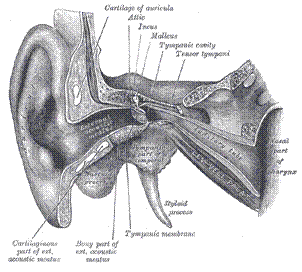Ears Terms
Craniofacial differences have a big impact on a child’s outer, middle and inner ear structures. And structural changes to the ear affect not only your child’s ability to hear, but their ability to speak, learn, and maintain balance. So take time to understand the capabilities and liabilities related to the ear, and you’ll be prepared to help your child make the most of their abilities.

Audiologist
Refers to a person with a degree, license, and certification in audiology (audio=sound; ology = study of; the science of hearing) who measures hearing, identifies hearing loss, and participates in rehabilitation of hearing impairment.
Auricle, or Pinna
Refers to the flexible, soft tissue/cartilage outer portion of the ear which gathers and channels sound vibration information into the outer ear canal, to be sent on through the ear sound system to the brain for response: aur= having to do with sound; icle- part, or connected structure.
Aural Atresia
Refers to the condition in which the ear canal doesn’t develop, leaving the child with an outer and middle ear, but no inner ear.
Canal
Refers to the one-inch tubal segment of the middle ear, made of cartilage and lined with dust-diverting
hair follicles and wax glands which prevent dust and insects or other tiny foreign bodies from entering
the ear.
Communication Disorder
Refers to the condition in which the child or adult cannot clearly express themselves, and/or cannot grasp what others are communicating to them. Most often, the disorder relates to speech/verbal communication.
Consonant
Refers to any of the alphabet letters/sounds other than the vowels: a, e, I, o, and u.
Ear Sound System
Refers to the ear’s five-part sound system that works by teamwork as with a relay team: the outer ear,
the middle ear canal and ear drum, and the inner ear’s incus/malleus/stapes structures. The parts
gather information from the outside world, decode the sound into bits of information, and attach meaning
to the information according to personal ‘hearing’ history, instinct and intellectual recognition.
E.N.T.
Refers to a specialist physician who is licensed and degreed to care for all conditions related to the ears, nose, and throat.
Middle Ear
Refers to the air-filled ear segment running from the eardrum at the end of the ear canal, on past the three tiny sound-translation bones, to the ‘oval window’ of the inner ear. The bones (ossicles: os=bony, icles=structures) form a continuous connection from the middle ear to the inner ear. When sound strikes the eardrum, it vibrates and pushes against the ossicles, changing the sound wave into a mechanical movement. In order of outermost to innermost structures:
Ear Drum
Refers to the tiny membrane inside your ear which vibrates when your child hears, and transmits the vibrations to the middle ear sound conduction bones; also called the Tympani.
Hammer or ‘malleus’
Refers to the first of the ossicles, connected directly to the eardrum: malleus: mall=mallet or hammer.
Anvil or ‘incus’
Refers to the second ossicle bone connected to both the hammer and the stirrup/stapes bones: incus= anvil.
Stirrup or ‘stapes’
Refers to the third middle ear bone of the 3-part chain, which moves in and out based on the pattern of incoming sound waves (stapes= stirrup). The bottom of the stapes (where the foot rest in a stirrup would be) rests inside of an oval ‘window’ which marks the beginning of the inner ear.
Eustachian Tube
Refers to the ‘air vent’ tube running from the front of the middle ear, to the back of the throat area (nasopharynx: naso=nose, pharynx= upper throat); it allows air pressure to be equalized on both the outside and inside segments of the ear. Yawning, chewing, swallowing, and going up in a plane or high elevator can all cause the air pressure to change noticeably – making the ears “pop”.
Inner Ear
Refers to the ear’s innermost group of four sensory organs used for hearing and balance.
Inner Ear Hearing Structures
The bony, fluid-filled, snail-shaped cochlea ‘hears’ with a tiny Organ of Corti via tiny hair cells
that receive information. The cochlea also has an ‘oval window’ membrane to pick up vibrations from
the middle ear; the membrane’s movements pushing the fluid in the Cochlea, and stimulating the hair
cells at certain pitches of sound. The hair cells create and send nerve signals through the acoustic
nerve to the midbrain to make sense of what’s being heard. Signals from both ears reach the midbrain
and divide pathways, so that both sides of the brain receive information from both outer sides of
the head.
Balancing Structures
Refers to the fluid-filled, sensory hair-lined inner ear organs: the three interconnected semicircular canals that detect movement in three planes of space; as well as the connecting utricle and saccule which detect non-moving head position.
Myringotomy
Refers to the procedure in which we make a tiny slit into the lower section of the eardrum, insert a tiny ‘grommet’ tube, and so drain middle ear fluid out of the ear. We insert these tubes to prevent fluid build-up, ear pain, and ear infection if the Eustachian tube lies too flat within the middle ear, making normal drainage difficult.
Otitis Media
Refers to an infection and inflammation of the middle ear, causing mucous-like fluid build-up and pain inside the ear.
Otolaryngologist
Refers to the licensed, degreed medical specialist responsible for understanding and treating conditions of the head and neck, specifically as they relate to the ear, nose and/or throat.